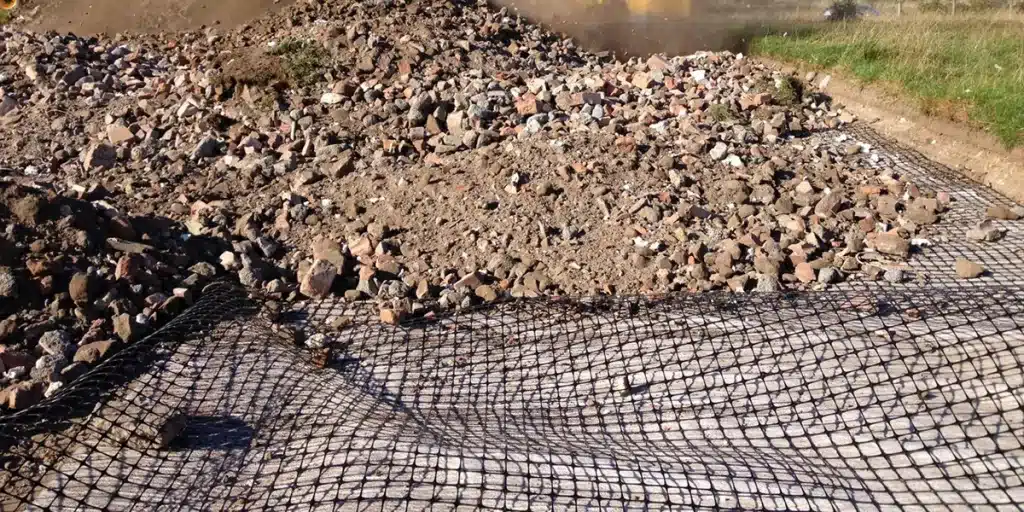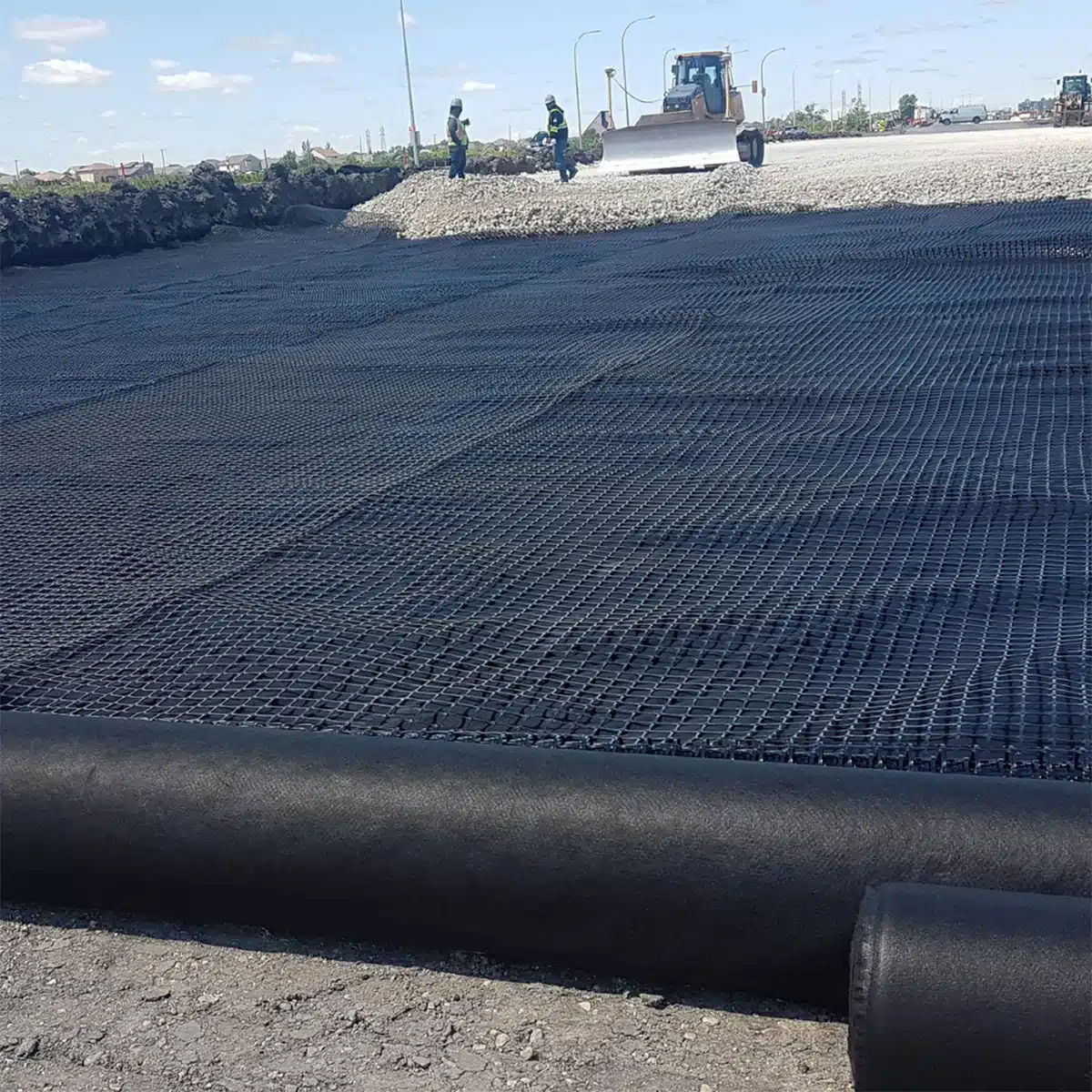+86-159 9860 6917
info@geofantex.com
geofantex@gmail.com
+86-400-8266163-44899
Geosynthetics play a pivotal role in bolstering the stability and durability of soil structures in diverse civil engineering endeavors. These innovative materials, encompassing geogrids, geotextiles, geocomposites, and more, are engineered to fortify soil, providing enhanced strength and resilience. Their strategic integration reinforces soil, mitigates erosion, and enhances load-bearing capacities, ensuring the longevity and reliability of construction projects. Discover how geosynthetics revolutionize soil reinforcement, offering sustainable solutions and greater structural integrity for diverse engineering applications.

Can geosynthetics be used as a soil reinforcement?
Yes, geosynthetics can be used effectively as soil reinforcement. Geosynthetics are synthetic materials used in civil engineering applications, particularly in soil-related projects. There are several types of geosynthetics, including geotextiles, geogrids, geomembranes, geocomposites, and geonets, each with specific functions and applications.
Types of Geosynthetics Used for Soil Reinforcement
Geotextiles:
- Function: Separation, filtration, drainage, reinforcement.
- Application: Used to improve soil strength and stability by preventing the mixing of different soil layers, improving load distribution, and aiding in drainage.
Geogrids:
- Function: Reinforcement.
- Application: Used to reinforce soils by providing tensile strength, thereby improving the load-bearing capacity and reducing soil displacement. Commonly used in retaining walls, roadways, and embankments.
Geocells:
- Function: Confinement, reinforcement.
- Application: Used to confine soil, reduce erosion, and increase load distribution. Effective in slope stabilization, load support, and erosion control.
Benefits of Using Geosynthetics for Soil Reinforcement
- Enhanced Strength and Stability: Geosynthetics can significantly improve the mechanical properties of soil, increasing its bearing capacity and stability.
- Reduced Settlement and Deformation: They help in minimizing settlement and deformation of soil structures, leading to longer-lasting and more reliable infrastructure.
- Cost-Effectiveness: Use of geosynthetics can reduce the need for high-quality fill materials and extensive earthworks, lowering overall project costs.
- Environmental Benefits: Geosynthetics can reduce the environmental impact by minimizing soil disturbance and material usage.
Applications of Geosynthetics in Soil Reinforcement
- Retaining Structures: Geogrids and geotextiles are used to reinforce retaining walls and steep slopes, improving stability and load-bearing capacity.
- Road Construction: Geotextiles and geogrids reinforce the subgrade, distribute loads, and prevent rutting and cracking.
- Embankments and Slopes: Geocells and geogrids stabilize embankments and slopes, reducing the risk of landslides and erosion.
- Foundations: Geosynthetics are used to reinforce foundations, especially in soft soil conditions, improving the bearing capacity and reducing settlement.
Design and Installation Considerations
- Material Selection: Choosing the appropriate type of geosynthetic based on the specific application and soil conditions is crucial.
- Installation Technique: Proper installation methods must be followed to ensure the effectiveness of the geosynthetics in reinforcing the soil.
- Quality Control: Regular inspection and quality control measures are necessary to maintain the integrity and performance of geosynthetic-reinforced structures.
In summary, geosynthetics are versatile and effective materials for soil reinforcement, offering numerous advantages in terms of strength, stability, cost-effectiveness, and environmental impact. Their applications span various civil engineering projects, making them an essential component in modern construction and infrastructure development.
Geosynthetics, which include geotextiles, geomembranes, and geogrids, are used effectively in soil reinforcement due to their versatile properties. Here’s a detailed look at their applications, benefits, and considerations:
Applications:
- Reinforced Soil Structures: Geosynthetics are commonly used to build retaining walls, slopes, and embankments. They provide structural stability by distributing loads across a wider area.
- Erosion Control: They act as barriers to prevent soil erosion in coastal areas, riverbanks, and slopes.
- Pavement Reinforcement: Geosynthetics improve road durability by reducing rutting and extending pavement life.Separation and Filtration: In road construction, they prevent different soil layers from mixing, ensuring proper drainage and foundation stability.
Benefits:
- Load Distribution: By dispersing loads, geosynthetics reduce pressure on the soil, preventing settlement and enhancing stability.
- Cost-Effectiveness: Their use often reduces the need for expensive earthwork, offering economical solutions in challenging terrains.
- Flexibility: They adapt well to varied soil conditions, enabling their use in different environments.
- Durability: They resist chemical and biological degradation, ensuring long-term performance.
Considerations:
- Material Selection: Choose the appropriate geosynthetic based on soil type, expected load, and environmental conditions.
- Installation Techniques: Proper installation is crucial for maximizing effectiveness, requiring skilled labor.
- Environmental Impact: Ensure the materials are compatible with the site’s environmental policies and standards.
What are geosynthetics used for soil stabilization?
Geosynthetics are extensively employed in soil stabilization, a process crucial for enhancing the load-bearing capacity of the ground:
- Reinforcement: Geogrids and geotextiles are commonly used to reinforce soil. Geogrids, with their high tensile strength, are placed within the soil to distribute loads effectively. This reinforcement reduces soil movement, improves stability, and prevents surface rutting or cracking in roads and embankments. Geotextiles act as a barrier, separating different soil layers and preventing intermixing, which can compromise structural integrity.
- Erosion Control: Geosynthetics are employed to mitigate erosion problems. Geotextiles are often used in erosion control blankets or mats to protect soil from the impact of water flow, wind, or surface runoff. These materials stabilize the soil surface, reducing erosion and maintaining the integrity of slopes, channels, and embankments.
- Drainage Improvement: Certain geosynthetics, like geocomposites and geonets, facilitate effective drainage. They provide pathways for water to move away from the soil, preventing saturation and potential instability. By enhancing drainage, geosynthetics contribute to maintaining the structural integrity of the soil.
- Slope Reinforcement: Geosynthetics are crucial in reinforcing slopes and retaining walls. Geogrids and geotextiles are installed on steep slopes to prevent soil slippage, thereby enhancing stability and minimizing the risk of landslides. These materials also support vegetation growth, further aiding in slope stabilization.
- Road Construction: Geosynthetics are extensively used in road construction to improve the performance and longevity of pavement structures. They are placed beneath road surfaces to distribute loads, reduce deformation, and enhance the bearing capacity of the soil, thereby improving the overall stability of the road.
What is the use of geosynthetics for strengthening the soil of the foundation?
Geosynthetics are widely used in civil engineering for soil reinforcement, particularly in the context of strengthening the foundation of structures. They offer several benefits and come in various forms, such as geotextiles, geogrids, geomembranes, and geocomposites. Here are the key uses and advantages of geosynthetics in soil reinforcement:
Improved Load-Bearing Capacity
- Geotextiles and Geogrids: These materials help distribute loads more evenly across the soil, reducing stress concentrations and increasing the overall load-bearing capacity of the foundation.
- Mechanism: Geogrids, for example, provide tensile strength to the soil, helping to confine soil particles and improve interlock, which enhances stability and load distribution.
Soil Stabilization
- Erosion Control: Geotextiles are used to prevent soil erosion by stabilizing the surface. This is particularly useful in slopes and embankments where erosion can undermine the foundation’s stability.
- Drainage Improvement: Geocomposites, which combine geotextiles with drainage cores, facilitate proper water drainage, reducing the risk of soil liquefaction and maintaining soil strength.
Reduction of Settlement
- Uniform Settlement: By reinforcing the soil, geosynthetics help achieve more uniform settlement across the foundation area, minimizing differential settlement that could damage structures.
- Preload Reduction: Geosynthetics can be used in combination with preloading techniques to accelerate soil consolidation and reduce long-term settlement.
Reinforcement of Weak Soils
- Soft Soil Improvement: Geosynthetics are particularly useful in improving the strength and stability of weak or soft soils. They provide additional support and reduce the deformation of the soil under load.
- Embankment Construction: For constructing embankments on soft soils, geosynthetics provide the necessary reinforcement to prevent excessive deformation and failure.
Slope Stability
- Increased Stability: Geogrids and other reinforcement materials enhance the stability of slopes and embankments by providing additional tensile strength, preventing landslides, and maintaining the integrity of the slope.
- Retaining Walls: Geosynthetics are used in the construction of retaining walls to reinforce the soil behind the wall, increasing its stability and load-carrying capacity.
Filtration and Separation
- Geotextiles as Filters: They act as filters to allow water to pass through while retaining soil particles, thus preventing soil erosion and maintaining soil structure.
- Separation Layers: Geosynthetics are used to separate different soil layers, preventing the mixing of materials and maintaining the integrity and strength of each layer.
Cost-Effectiveness and Sustainability
- Reduced Material Usage: By improving the soil’s strength and stability, geosynthetics reduce the need for extensive excavation and replacement with high-quality fill materials, leading to cost savings.
- Sustainable Construction: The use of geosynthetics promotes sustainable construction practices by reducing the carbon footprint associated with material transportation and excavation activities.
Practical Applications
- Road Construction: Geosynthetics reinforce the subgrade, improve load distribution, and extend the lifespan of roads.
- Foundation Reinforcement: Used under buildings, bridges, and other structures to enhance foundation performance.
- Landfills: Geomembranes and geotextiles are essential in landfill construction for containment and leachate management.
In summary, geosynthetics play a crucial role in foundation soil reinforcement by improving load-bearing capacity, reducing settlement, stabilizing slopes, and enhancing overall soil performance. Their versatility, cost-effectiveness, and sustainability make them indispensable in modern civil engineering projects.
What materials are used in soil reinforcement?
Soil reinforcement involves incorporating various materials into soil to improve its mechanical properties, such as strength, stability, and durability. The materials used for soil reinforcement can be broadly classified into the following categories:
- Geotextiles: These are permeable fabrics used to separate, filter, reinforce, protect, or drain soil. They are made from polymers such as polyester or polypropylene.
- Geogrids: These are grid-like synthetic materials made from polymers (e.g., polyethylene, polypropylene) used to reinforce soils. They provide tensile strength and distribute loads over a larger area.
- Geomembranes: Impermeable membranes are used primarily for containment and environmental protection, but can also be used in soil reinforcement applications.
- Geocells: Three-dimensional honeycomb-like structures made of polymeric materials, used to confine and stabilize soil, particularly in slope and embankment applications.
Natural Fibers
- Coir (Coconut Fiber): Biodegradable and durable, coir is used for erosion control and soil stabilization.
- Jute: Another biodegradable option used for temporary soil reinforcement and erosion control.
- Bamboo: Used in certain regions due to its high tensile strength and sustainability.
- Wood Mulch: Sometimes used in bioengineering applications for short-term soil stabilization.
Metallic Materials
- Steel Strips: Often used in retaining walls and embankments, steel strips provide high tensile strength.
- Welded Wire Mesh: Used in reinforced soil structures, it helps in load distribution and soil stabilization.
Cementitious Materials
- Lime: Used to stabilize clayey soils, improving workability and increasing strength.
- Cement: Mixed with soil to create soil cement, which is used in road construction and as a base for various structures.
- Fly Ash: A byproduct from coal combustion, used to enhance soil properties and reduce environmental waste.
Polymeric Materials
- Plastic Strips: Recycled plastic materials can be used to reinforce soil, providing a sustainable and effective solution.
Composite Materials
- Fiber-Reinforced Polymers (FRPs): These combine fibers with polymer matrices, offering high strength-to-weight ratios and durability.
Natural Stabilizers
- Enzyme Solutions: These are biodegradable and non-toxic, used to improve soil compaction and stability.
- Bitumen: Used to stabilize soils in road construction, enhancing resistance to water and load-bearing capacity.
Each material type has specific applications based on the required properties, environmental conditions, and project requirements. The selection of reinforcement material depends on factors such as soil type, load conditions, environmental impact, and cost-effectiveness.

In conclusion, geosynthetics have emerged as indispensable elements in soil reinforcement methodologies, offering versatility, durability, and adaptability across diverse construction projects. Their ability to bolster soil stability, prevent erosion, and enhance foundation strength has propelled them to the forefront of modern engineering practices, revolutionizing the way we approach soil reinforcement.



Get Free Sample
We’ll respond as soon as possible(within 12 hours)






















